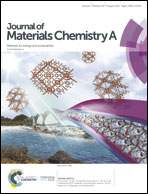Boosting the initial coulombic efficiency in silicon anodes through interfacial incorporation of metal nanocrystals†
Abstract
Silicon-based anodes generally suffer from huge volume change and continuous formation of unstable solid-electrolyte interfaces (SEIs) during lithiation/delithiation processes. The most promising strategy to solve this problem is to introduce a coating layer. For instance, a carbon coating layer not only enhances the electrical conductivity, but also serves as a structural buffer to relieve the huge volume expansion. However, the introduction of a carbon layer generally increases the specific surface area of the active material and results in excessive formation of SEI films, resulting in the degradation of the initial coulombic efficiency (ICE). To overcome these challenges, we propose a strategy of interfacial incorporation of metal nanocrystals to boost the ICE from 76.9% to 79.9%. This design relies on a satellite-like architecture, where metal nanocrystals (such as Ag, Cu and Fe) are decorated on the surface of polydopamine-derived carbon-encapsulated commercial silicon nanoparticles. In this regard, the metal nanocrystals promote the improvement of electrical conductivity and reduce the inter-particle resistance, thus significantly raising the ICE value. This new insight may contribute to a better understanding of the ICE and the rational design of other anode materials for lithium-ion batteries.



 Please wait while we load your content...
Please wait while we load your content...